This is a Pentax PC35AF, a 35mm compact camera made by the Asahi Optical Co. in Tokyo Japan between the years of 1982 and 1984. It was the first compact Pentax camera capable of auto focus and was the first in a long running PC-series of cameras released. The PC35AF had a good 5-element lens in stout body that despite it’s consumer feature set, was quite capable of making good images. The camera originally came with manual film advance, but an accessory power winder was available as an option.
Film Type: 135 (35mm)
Lens: 35mm f/2.8 Pentax coated 5-elements
Focus: 0.7 feet to Infinity with Infrared Active Auto Focus
Viewfinder: Albada type with 35mm projected bright lines and focus distance confirmation
Shutter: Electronic Leaf
Speeds: 1/8 – 1/430 seconds continuously variable
Exposure Meter: Coupled CdS Cell w/ Programmed Auto Exposure
Battery: 2 x AAA Alkaline or NiMH
Flash Mount: Integrated Pop-Up Flash
Weight: 312 grams w/ batteries
Manual: http://www.cameramanuals.org/pentax_p&s/pentax_p&s_pc35_af.pdf
My Thoughts
Perhaps one of the best kept secrets in the underground world of camera collecting is that not every plastic point and shoot camera from the 1980s is garbage. Okay, that’s not really much of a secret as cameras like the Yashica T-series with their Zeiss glass, the original Nikon L35AF, and the Olympus XA-series have been darlings of the hobby for quite some time.
So I’ll revise my statement and say there are other good compact point and shoot cameras from the 80s besides the ones people already talk about. The Pentax PC35AF is one of those cameras.
Debuting in 1982, it was the very first 35mm compact auto focus camera made by Asahi Optical Co. (they didn’t become officially known as Pentax until 2002). Asahi was rather late to the game in this segment as other Japanese companies like Konica and Canon had models with a similar feature set released several years prior.
The Pentax PC35AF has a rather unique feature set, one that few could exactly match. The highlights include a quality 5-element f/2.8 lens which was a step up above other 3 and 4-element designs of lesser cameras. It has a continuously variable shutter with speeds from 1/8 to 1/430 meaning that the exposure system will choose the exact shutter speed that is required for available light.
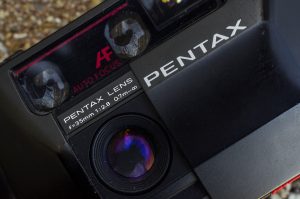
Finally, there is an infra-red auto focus sensor that could variably detect focus from 0.7 meters to Infinity. This is in contrast to passive systems that use electronic rangefinders like Konica and Canon sometimes used. Also, the fact that it could infinitely focus was useful too as many early auto focus cameras were “auto zone focus” which means the lens was only designed to detect 3 specific distances (usually a close-up distance, group shot distance, and infinity) and would rely on depth of field to accommodate anything in between. With a variable auto focus system, if the camera detects the subject is 4 feet away, it will focus to 4 feet, if they’re 14 feet, it will focus to 14 feet, etc. This means that more of your shots should be correctly in focus, but also, the camera doesn’t have to rely on small apertures to get correctly focused shots.
One area in which the Pentax PC35AF differs from other auto focus cameras of the era is that it still has a manual film advance and rewind, instead of the increasingly automatic everything designs that were becoming common in the early 1980s. I can’t speak for how this might have been perceived by consumers upon the camera’s release, but today I find this to be a benefit rather than a con. For one, it keeps the size of the camera down, not requiring the extra gears and electric motor to automatically advance film, but also it means that the camera can be used much more discreetly due to the lack of a loud grinding noise typical of motorized film advances of the day. The leaf shutter design of the camera is extremely quiet and after making an exposure, you simply wind the film with your thumb.
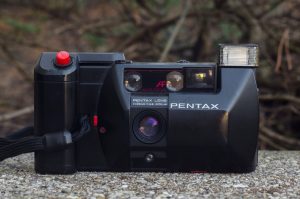
If a motorized wind was a deal breaker for you, there was an optional add-on accessory that would clip to the side of the camera, covering the film advance wheel, and upon firing the shutter, would advance the film for you. Not only does this accessory increase the size of the camera, but since it requires it’s own batteries, it adds to the weight, and of course the sound. Although this accessory was frequently sold with the camera, I have to wonder how many people actually used it.
There seems to have been enough of a need for a motorized film advance that when Asahi released the PC35AF’s successor (called the PC35 AF-M) in 1984, this feature was built into the camera.
Staying on the topic of “camera sounds”, I’ll switch to perhaps the worst design element of this camera, which is an infuriating buzzer that the camera has to warn you to use the flash. Like most compact cameras of the day, the PC35AF will notify you when it has determined that a shutter speed of less than 1/30 is going to be used and that you either need to use a flash or stabilize the camera to prevent motion blur. Unlike other compact cameras that rely on a simple LED or flag in the viewfinder, this camera has a loud buzzing noise that negates any stealth the camera might have gained to the lack of a motor wind. Strangely, this buzzer isn’t even necessary as there is also an orange LED that illuminates within the viewfinder simultaneously when the buzzer is going off. Did they really need to give you lights AND sound?
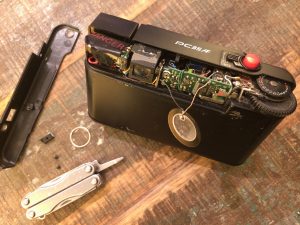
Even more irritating is that Pentax offers no way to silence the camera. Thankfully we have a resource today called the Internet that didn’t exist back when this camera was first released, and there are guys like Hamish Gill who figured out a really simple way to silence the piezo-electric buzzer by removing the top plate and cutting it out. Check out Hamish’s review for the complete instructions.
Moving past the noises of the camera, the rest of the interface works quite well. The camera is compact enough to not be obtrusive, but will still fit in a coat pocket or small purse. Although made almost entirely of plastic, I found the camera to be sturdy and well built.
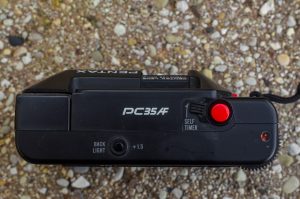
The top plate of the camera is pretty spartan, with the logo, a +1.5 EV backlight button, the electronic self timer switch, automatically resetting exposure counter, and the large red shutter release button.

The bottom of the camera has a flip up rewind lever, rewind release button, tripod socket, flash release, and a sliding switch to select your chosen film speed from 25 to 400. DX encoding for automatic film speed detection was not available until January 1983, so this model predates the widespread use of this feature, which today is actually a blessing as you can shoot expired or bulk rolled film in the camera and manually set the exposure based on what you’ve loaded.
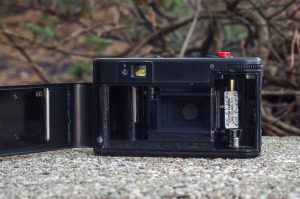
To load film into the camera, pull up on the rewind knob which acts as a door release, and the rear door opens to reveal the film compartment. Strangely, the PC35AF loads right to left, as opposed to left to right. I say “strangely” as the wind knob is on the right side of the camera, but the take up spool is on the left. This means that there is some type of extended linkage between the knob and the spool whcih I have to imagine could have been a failure point on at least some of these cameras. Thankfully mine had no such problem, but it seems like an unnecessary design challenge.
The camera has no quick load system. You have to manually thread the film leader into the take up spool and advance it a couple of times to make sure it is securely attached. This, like the lack of a motorized wind suggests that this camera was designed to keep the cost of the camera down. According to the December 1983 issue of Popular Science, the Pentax PC35AF had a list price of $169 without the winder, which makes it the 3rd cheapest of the 13 cameras reviewed in that issue. Even when adding in the $34 power winder, the price of the camera is still in the bottom half of the models tested.
Despite these perceived omissions, the rest of the camera offers a pretty good value. For one, the 5-element Pentax 35mm f/2.8 is as good as any out there. The Popular Science article mentioned above does not comment on the makeup of the lenses in the other 12 cameras, but I have to believe that quite a few of them were 4-element designs.

The popup flash has a respectable range of up to 4 meters when using ISO 100 film, and 6 meters when using ISO 400 film. You can use the flash both indoors and as a fill flash outdoors. The camera will always use the flash whenever you activate it using the release button on the bottom of the camera. Just make sure the flash ready light next to the viewfinder is lit before trying to use it.
The camera has features like a back light adjustment button, a self timer, and a built in lens shield which some of the other models didn’t have. The exposure meter relies on a CdS cell and has an effective range of EV 6 – 17 matching the highest priced models in the comparison.
It seems that Asahi made wise choices in the design of this camera, incorporating the best features to keep it competitive with much more expensive cameras, while omitting a few less critical ones in an effort to keep the price down.
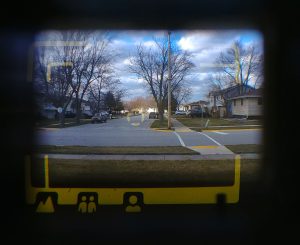
In use, I found the viewfinder to be large and bright and easy to compose with, both indoors and outdoors. Visible in the viewfinder are projected frame lines for the 35mm semi-wide angle lens, with manual parallax hash marks. There is an LED indicator at the top of the viewfinder that is coupled to that annoying buzzer I mentioned earlier. Green means that flash is not needed, but orange is when the buzzer goes off. Finally, there is a selected focus scale at the bottom with three icons, representing Portraits (single head), Groups (3 heads), and Landscapes (mountains). A needle will move according to the selected distance that the auto focus sensor has detected. This type of 3 icon system was employed by many other camera makers, but I love how it works in the Pentax PC35AF in that the needle will move BEFORE firing the shutter. This allows you to confirm that the camera has selected an appropriate distance to your subject without having to fire the shutter. In some other early auto focus cameras like the Canon MC, this needle doesn’t move until after firing the shutter.
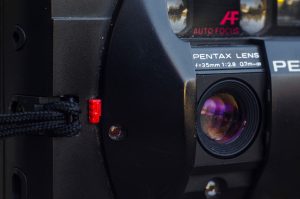
The PC35AF has no power switch, but that is because the camera essentially shuts off when you close the sliding lens cover on the front of the camera, and powers back on when you open it. The front cover is spring tensioned and released by a red switch on the front of the camera. A quick flick on the finger and the front door quickly springs open readying the camera for use. This is a nice improvement to other cameras like the Olympus XA2 which require you to manually slide the camera open.
When holding the PC35AF, it is clear that Asahi did their homework. The controls on the camera are well laid out, the 5-element lens suggests quality photographs, the built in flash allows for flexible use indoors and as a fill flash outdoors, and the lack of a motorized film advance (and rewind) means this camera can be used discreetly. It seems the PC35AF looks pretty good on paper, but how is it really?
My Results
Reviewing and writing about cameras is something I do year round in my free time. Unfortunately, the weather in my area of the world isn’t so kind to shooting interesting photos year round. I tend to go into a lull in the winter months, but on occasion, I get “the bug” to go out and shoot. Such was the case this past February when temps were well below freezing. I needed to load film into something and go shooting.
I picked the Pentax PC35AF even though I had never shot it before, because I wanted to see what it’s fully automatic exposure and focusing system could get out of the dreary winter landscapes around my house. I also had the opportunity to take it with me to the Chicago Auto Show where I got to test it out indoors under the glow of thousands of different LED, florescent, halogen, metal-halide, and who knows what other kinds of lights. The color temps of lights at indoor events vary wildly and can wreak havoc on even the most advanced exposure systems. My film of choice was my standard Fuji 200.
If I had to pick one word to describe the PC35AF, it would be “fantastic”, if I had to pick a second, it would be “classic”. This truly is a fantastic classic. The Pentax PC35AF combines many of the features I love about film cameras into an easy to use and compact little machine. For starters, the 5-element lens renders shots with excellent sharpness across the flame, excellent color rendition (even indoors under harsh artificial light), and when shot at smaller apertures outdoors, gives an ever so slight vignetting that adds just a bit of charm.
Despite still being a 1st generation auto focus system, it worked remarkably well. Of the 24 exposure roll, it missed focus only once. Exposure was spot on, suggesting that whatever meter is in this camera is still working as good as the day it was made.
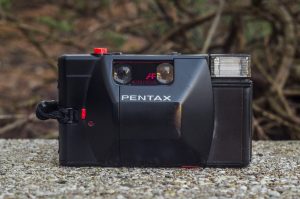
The camera is a little larger than the Olympus XA series, but on par with other classics like the Canon AF35M and Nikon L35AF making for an extremely portable design. I actually didn’t mind that the film advance was manual. Despite having the automatic accessory, I never had the desire to use it. I appreciated the quietness of this camera. The process of taking a photo is a barely audible click as the shutter fires, followed by the quiet ratcheting sound of the film advance. I get why people might have passed over this model back in 1982 when there were many other options that were more automatic, but I’d say the lack of the “UPS Dump Truck” sounding motor wind of early 80s film advances is a fine compromise.
With sold prices for the Nikon L35AF exceeding well over $100 in working condition, it’s unlikely anything I say here will elevate the Pentax PC35AF to those lofty heights, which means that if you happen to come across one of these, you have yourself a really capable camera with an excellent lens, excellent meter, and really good auto focus system.
My favorite kinds of cameras are the hidden gems that are often overlooked. The bargain basement models that maybe at one time were well regarded models, but have slipped through the cracks of time into near obscurity. The Pentax PC35AF is one of those cameras.
My Final WordHow these ratings work |
The Pentax PC35AF is a wonderful camera from the “glory days” of the auto focus point and shoot era. It has a unique combination of fully automatic exposure and focus, but with a manual wind and rewind. This means the camera lacks the loud electronic motors that most models of this era had making it an ideal discreet camera. The 5-element f/2.8 lens is surprisingly sharp and capable, rendering images that are on par with mid level SLRs of the day. These cameras aren’t nearly as desirable as Olympus, Canon, and Nikon cameras of the day, but that doesn’t mean it’s any less capable. If you can find one of these in working condition, I strongly recommend giving it a shot! | ||||||
| Images | Handling | Features | Viewfinder | Feel & Beauty | History | Age | |
| 2 | 2 | 1 | 1 | 1 | 0 | 0% | |
| Bonus | +1 for the complete package, point and shoot compacts don’t get much better than this | ||||||
| Final Score | 8.0 | ||||||
Additional Resources
http://camera-wiki.org/wiki/Pentax_PC35_AF
https://www.35mmc.com/15/05/2014/pentax-pc35af/
https://mycameracabinet.wordpress.com/2016/12/05/pentax-pc35af/
https://www.lomography.com/magazine/335169-lomopedia-pentax-pc35af
https://www.flickr.com/groups/71144703@N00/discuss/72157623296747092/

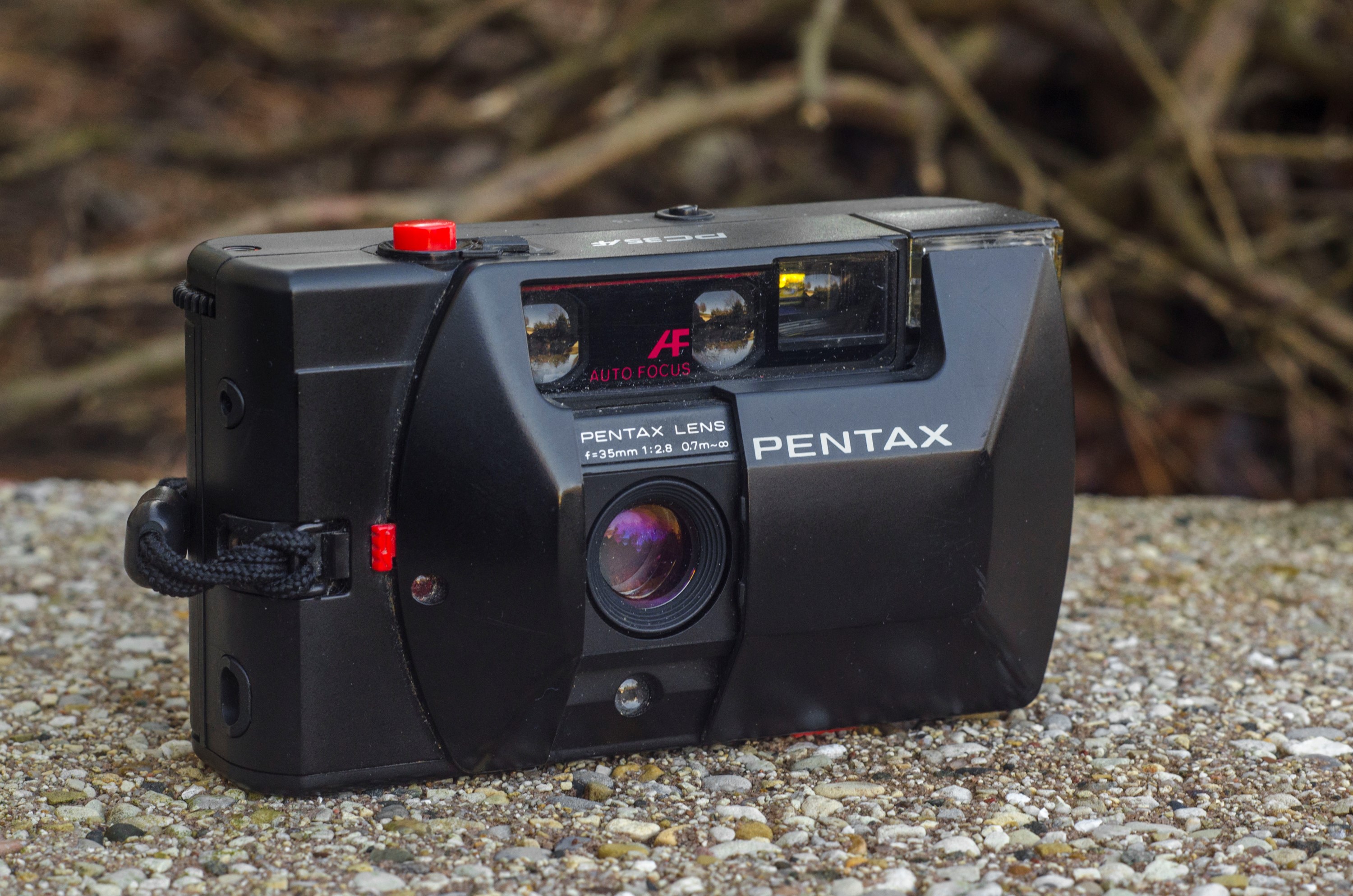
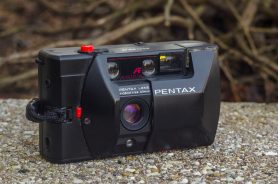
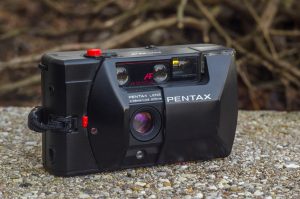








The Pentax PC35AF-M, in common with many auto advance AF compact cameras of the era, will only advance after you take a finger from the shutter. This allows you to take a shot and go somewhere more discreet to remove your finger and let the film wind on.
I agree it’s an underrated camera.
Are you sure about the the step-less focus system? Seems almost too good to be true when most other cameras of the day had only a few steps as you say. And stayed that way for almost a decade (the Mju i released almost 10 years later had 100 af steps and was something of a revolution at the time)
I mentioned in the review that the focus was infinitely variable based on what the user’s manual says. If you find different information to the contrary, let me know and I can update the review.
Plus one on your points, Mike. Nice review. You really zeroed in what makes it special by calling out the lens and manual winder, which make it easy to use discretely, and the drawback of the gimmicky low-light buzzer. I own the PC35 AF and the Olympus XA and Nikon L35 AF. In use and features it falls in between the two. It has a lens comparable to the Nikon and the form factor of the Olympus, although without autofocus. I like the spring door operation of the Pentax less than the Olympus. In operation, the Pentax is closer to the Olympus Stylus but without its automatic film advance. I would add that the PC35 AF has a nice viewfinder which is often lacking in other AF point-and-shoots. Thank you!